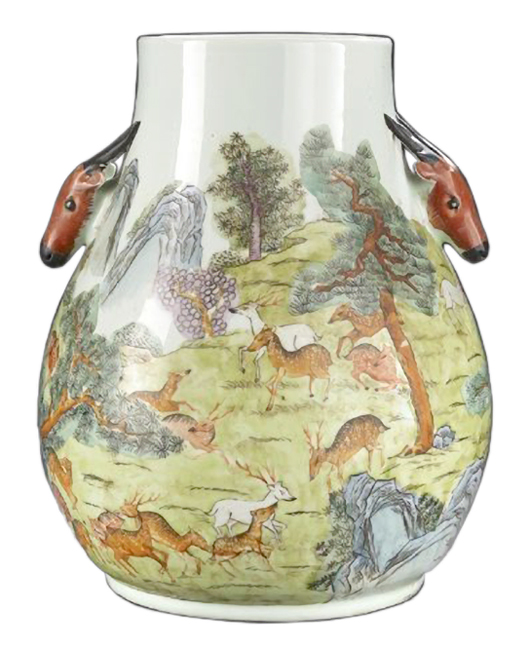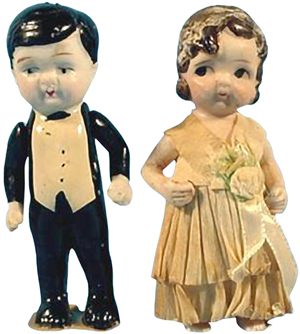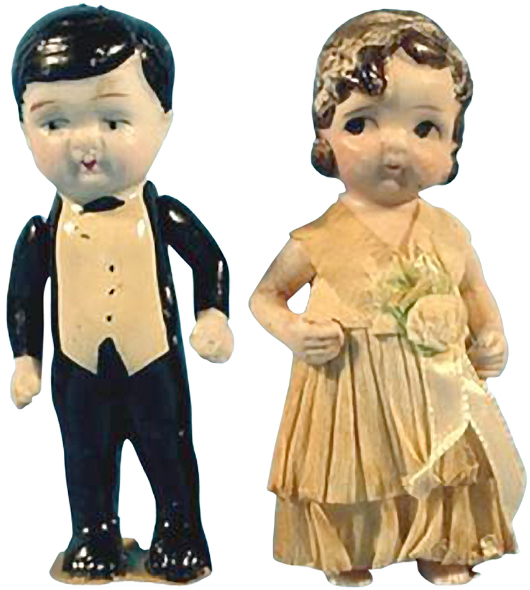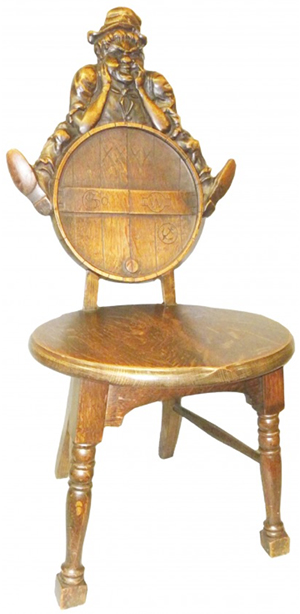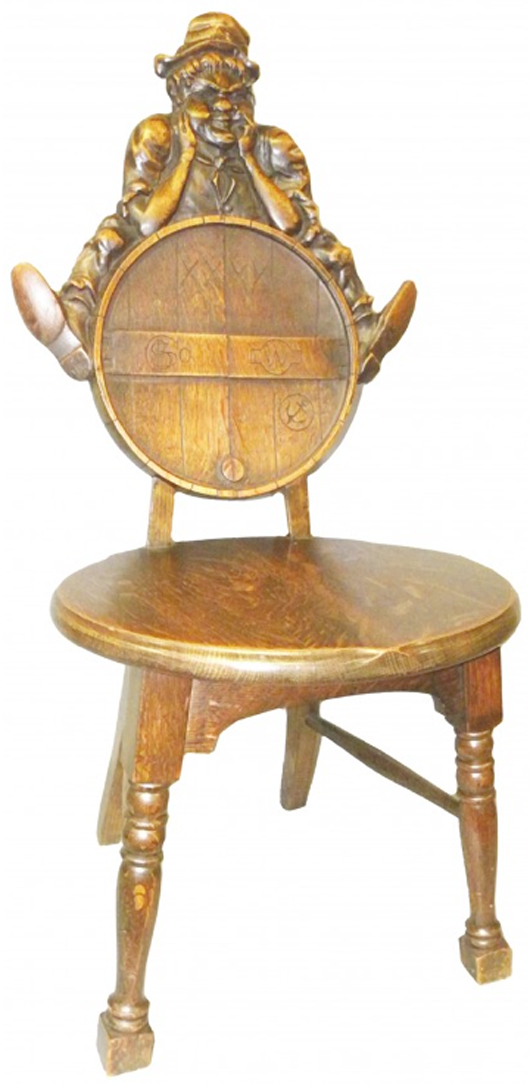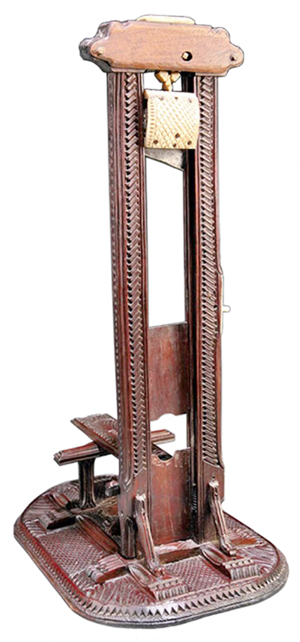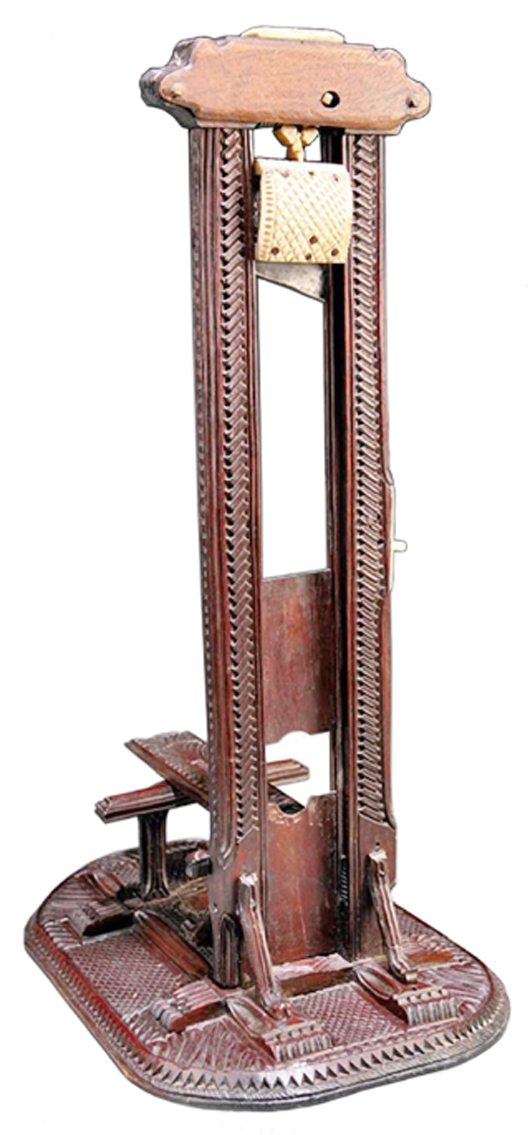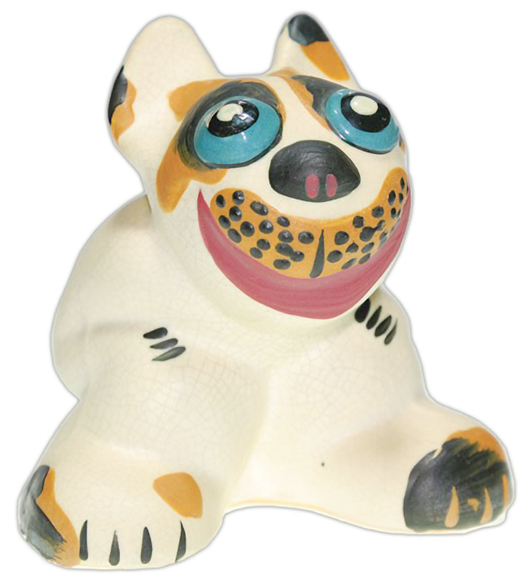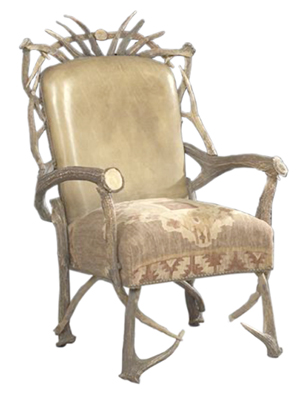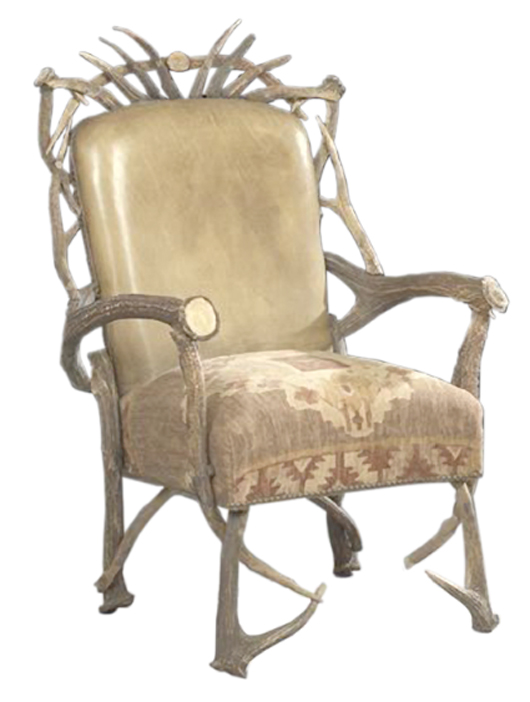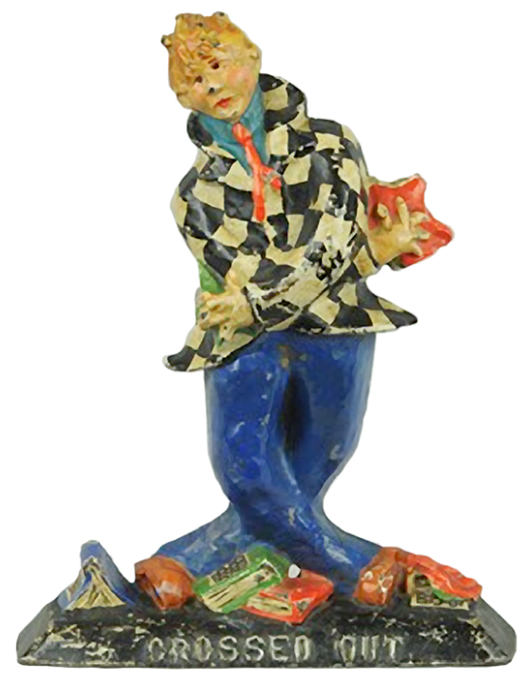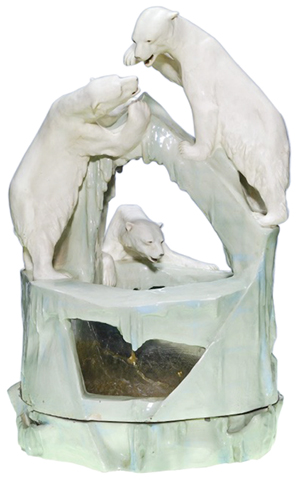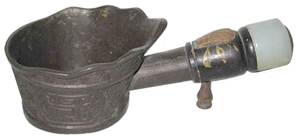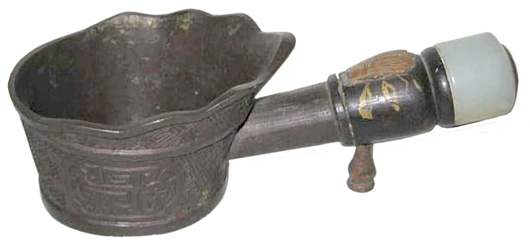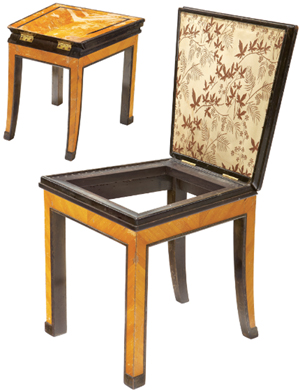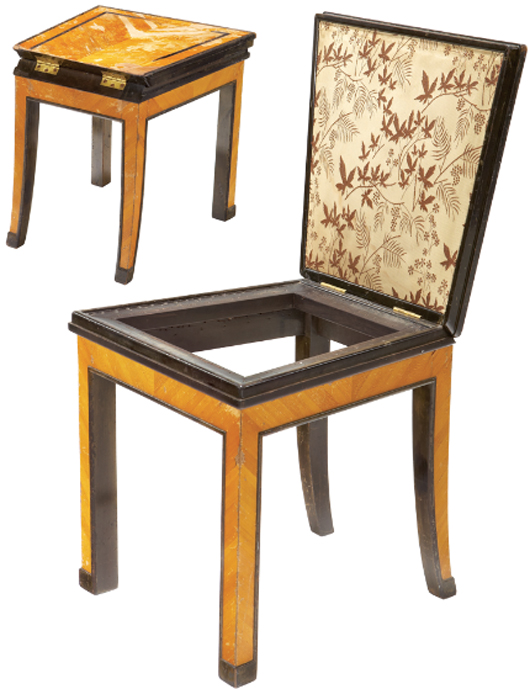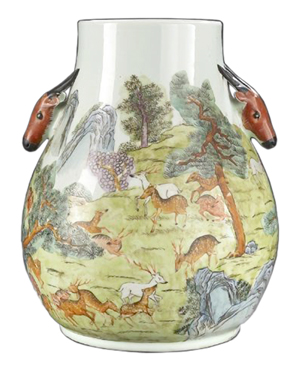
Chinese porcelains of past centuries are selling for very high prices today. There are many types. Some we identify by the color—like celadon (pale-green glaze) or blue and white (blue decoration on white porcelain, including varieties called Canton or Nanking) or multicolored patterns named for their dominant color, including famille rose, rose medallion, rose mandarin or famille verte (green).
Another American name for some Chinese porcelain is “Chinese export porcelain.” It was the made-to-order dinnerware manufactured in China but decorated in the European manner and sold to foreign countries in the 18th and 19th centuries. Because the Chinese often copy old pieces, those who have not studied antique Chinese porcelains can’t tell old from the new. Unrecognized bargains have been found in American homes. The properly identified pieces sell for thousands of dollars. Look for flawless glazes without unintentional bumps or flaws. Turn a vase over. The bottom rim that touches the tabletop is usually unglazed if Chinese. European foot rims and bottoms of lids are glazed. Decorations should be carefully painted in light, pleasing colors. Twentieth-century Chinese wares sold to other countries are often decorated with large figures without much detail and with gold and other bright colors. A close look at a fine-quality famille rose vase would show a scene with many small people and animals in a woodland or interior setting.
Prices of Chinese porcelain vary with the quality of the work and the age. If you plan to buy an expensive piece, get expert advice. If you own any heirloom porcelains, take a close look at them. Many 18th-century and earlier pieces have been rediscovered in recent years. A decorative piece your grandmother or great-grandmother bought years ago could be a treasure.
Q: I own a British coronation mug dated June 22, 1911. On the front, there’s a picture of King George V and Queen Mary above the phrase “Urmston Coronation 1911.” Is this of any value? My grandmother brought it to the United States from England.
A: Your coronation mug is 100 years old, which qualifies it as an “antique.” It’s a souvenir mug made for the coronation celebration held in Urmston, a town outside of Manchester, England. The coronation of King George V (1865-1936) took place in London on June 22, 1911. He had actually risen to the throne the year before upon the death of his father, King Edward VII. Many souvenirs of King George V’s coronation were made. A mug like yours auctioned last year for 10 British pounds, or a little more than $15.
Q: I have a commemorative silk handkerchief of the coronation of King George VI. It was given to my mom by her brother many years ago. It’s off-white with British flags and red polka dots along the sides and a picture of the king in one corner. The words of H.M. King George VI, May 1937″ surround his portrait. The edge of the handkerchief is blue. It’s 11 inches square. The movie The King’s Speech and the age of my handkerchief have made me curious. Does my hanky have any value beyond sentimental?
A: Commemorative souvenir items from the coronations, weddings and birthdays of royalty have been made since the 1800s. Great quantities of items have been made in pottery, glass, tin, silver and other materials, most with pictures of the monarchs and the date of the commemorated event. The movie may have stimulated interest in items related to King George VI, but the value of your handkerchief has probably not increased. It is worth about $30.
Q: I have a table lamp that was given to my aunt as a wedding present in 1922. I know it was made by the Mosaic Lamp Shade Co. of Chicago, but it looks so much like a Tiffany that it has been mistakenly appraised as such. I hope you can tell me something about the Chicago company and give me some idea of the value of the lamp.
A: Lamps with stained glass shades and bronze bases were first made by Tiffany in 1899. They were so popular that similar lamps were soon being made by several other companies. The company that made your lamp was listed in the 1910 Chicago city directory as “The Mosaic Shade Co.” It was in business from about 1905 to 1914. All Tiffany lamps are signed, and Tiffany lamps made after 1902 also are marked with the model number on the base and shade. Not all lamps made by Tiffany’s competitors are marked. Some lamps made by the Mosaic Shade Co. are marked with the name of the company on the base. The value of your lamp depends on the color and design of the shade, its size and its condition. Your lamp could sell for $2,000 to $3,000, if the shade is in good condition.
Q: I have my mother’s copy of the 1915 Priscilla Crochet Book. Would someone be interested in buying this?
A: Your crochet pattern book was published by the Priscilla Publishing Co. of Boston. Several “Priscilla Crochet” pattern books were published in the early 1900s. The secret to selling a collectible like yours is to reach a wide audience. You are almost sure to find someone interested in buying it. Several early Priscilla pattern books are being offered online for prices ranging from $10 to $20. The books have been reprinted.
Tip: Don’t mechanically buff silver. It will change the color and wear away bits of the silver.
Take advantage of a free listing for your group to announce events or to find antique shows and other events. Go to Kovels.com/calendar to find and plan your antiquing trips.
Terry Kovel answers as many questions as possible through the column. By sending a letter with a question, you give full permission for use in the column or any other Kovel forum. Names, addresses or email addresses will not be published. We cannot guarantee the return of any photograph, but if a stamped envelope is included, we will try. The volume of mail makes personal answers or appraisals impossible. Write to Kovels, Auction Central News, King Features Syndicate, 300 W. 57th St., New York, NY 10019.
CURRENT PRICES
Current prices are recorded from antiques shows, flea markets, sales and auctions throughout the United States. Prices vary in different locations because of local economic conditions.
- Fenton Glass Co. bell, blue satin glass, raised pattern of lovebirds, embossed “Bride & Groom,” glass clapper, 1973-’84, 4 3/4 x 3 1/2 inches, $15.
- Wedding trousseau set, bra and half-slip, organza, pink, gray and pink flowers, WonderBra Intima, 1960s, medium slip, $55.
- Royal Doulton Bridesmaid figurine, HN2874, white, holding colored flowers, 1979, 5 1/2 inches, $85.
- Wise Potato Chips sign, easel back, image of table set with bowl of soup, salad and chips, “Delicious with soups and salads,” circa 1954, 16 x 15 inches, $145.
- Plush German shepherd, “Arco,” mohair, sawdust stuffing, orange eyes, pink tongue, standing, ears pointed up, Steiff, missing button in ear, 1957-58, 7 x 8 1/2 inches, $175.
- Bakelite pin, three red cherries on green stem, leaves, 1930s, 2 3/8 inches, $225.
- “Get Smart” lunch box, Agents 86 & 99, K-13, metal, King Seeley Thermos Co., 1966, $290.
- Nutcracker, cat’s head, carved wood, glass eyes, pointy ears, Black Forest, circa 1900, 7 1/2 inches, $310.
- William IV cellarette, carved rosewood, domed lid with acanthus finial, removable bottle case, raised lotus feet, four cut crystal decanters, circa 1835, 36 x 20 inches, $4,180.
- Louis Vuitton steamer trunk, flat lift top, checkerboard canvas cover, lift-out trays, brass mounts, label, late 1800s, 28 x 43 x 24 inches, $6,035.
Give yourself or a friend a gift. Kovels’ Advertising Collectibles Price List lists more than 10,000 current prices of your favorite advertising collectibles, from boxes and bins to trays and tins. More than 400 categories are organized by brand name, company name, product or collectible. Plus 300 photographs, logos and trademarks. A 16-page color insert features important advertising collectibles. Clubs, publications, resources and a full index. Available at your bookstore; online at Kovels.com; by phone at 800-303-1996; or send $16.95 plus $4.95 postage to Kovels, Box 22900, Beachwood, OH 44122.
© 2012 by Cowles Syndicate Inc.
ADDITIONAL IMAGE OF NOTE
